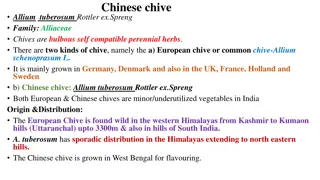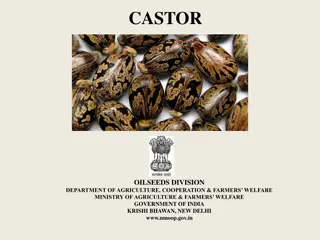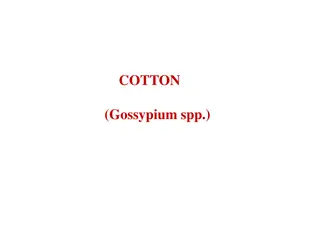Insights into Sugarcane Cultivation in India
Sugarcane, a vital crop in India, serves as a source of sugar, gur, and khandsari. Its growth conditions, including climate, soil requirements, and labor intensity, significantly impact its cultivation. With India being one of the world's largest sugarcane producers, the crop plays a crucial role in the country's agricultural landscape.
Uploaded on Jul 19, 2024 | 2 Views
Download Presentation

Please find below an Image/Link to download the presentation.
The content on the website is provided AS IS for your information and personal use only. It may not be sold, licensed, or shared on other websites without obtaining consent from the author. Download presentation by click this link. If you encounter any issues during the download, it is possible that the publisher has removed the file from their server.
E N D
Presentation Transcript
S. MAHESWARI S. MAHESWARI GUEST LECTURER IN GEOGRAPHY GUEST LECTURER IN GEOGRAPHY GEOGRAPHY OF INDIA GEOGRAPHY OF INDIA 03.09.2020 03.09.2020 III B.SC. GEOGRAPHY TOPIC : SUGARCANE IN INDIA
SUGARCANE IN INDIA SUGARCANE IN INDIA Sugarcane belongs to bamboo family of plants and is indigenous to India. It is the main source of sugar, gur and khandsari. About two- thirds of the total sugarcane produced in India is consumed for making gur and khandsari and only one third of it goes to sugar factories. It also provides raw material for manufacturing alcohol. Bagasse, the crushed cane residue, can be more beneficially used for manufacturing paper instead of using it as fuel in the mills. It is also an efficient substitute for petroleum products and a host of other chemical products. A part of it is also used as fodder. Sugarcane accounts for the largest value of production and holds an enviable position among all the commercial crops in India. Obviously, it is the first choice of the farmers, wherever geographical conditions favour its growth.
Conditions of Growth: It is a long duration crop and requires 10 to 15 and even 18 months to mature, depending upon the geographical conditions. It requires hot and humid climate with average temperature of 21 -27 C and 75-150 cm rainfall. In the latter half, temperature above 20 C combined with open sky helps in acquiring juice and its thickening. Too heavy rainfall results in low sugar content and deficiency in rainfall produces fibrous crop. Irrigation is required in areas receiving lesser rainfall than the prescribed limit. Short cool dry winter season during ripening and harvesting is ideal. Frost is detrimental to sugarcane. Therefore, it must be harvested before frost season, if it is grown in northern parts of the country where winters are very cold and frost is a common phenomenon. On the other hand, hot dry winds are also inimical to sugarcane. It can grow on a variety of soils including loams, clayey loams, black cotton soils, brown or reddish loams and even laterites. In fact, sugarcane can tolerate any kind of soil that can retain moisture. But deep rich loamy soils are ideal for its growth. The soil should be rich in nitrogen, calcium and phosphorus but it should not be either too acidic or too alkaline. Sugarcane exhausts the fertility of the soil quickly and extensively and its cultivation requires heavy dose of manures and fertilizers.-Flat plain or level plateau is an advantage for sugarcane cultivation because it facilitates irrigation and transportation of cane to the sugar mills.
It is a labour intensive cultivation requiring ample human hands at every stage i.e. sowing, hoeing, weeding, irrigating, cutting and carrying sugarcane to the factories. Therefore, cheap abundant labour is a prerequisite for its successful cultivation. Sugarcane Production In India: India has the largest area under sugarcane cultivation in the world and she is the world s second largest producer of sugarcane next only to Brazil. The cane production registered a dramatic increase of 93 per cent in the decade 1951-61 as a result of diversification of agriculture but this spurt slackened to 14.9 per cent growth between 1960-61 and 1970-71 mainly as a result of the farmers withdrawal of land under cane owing to internal market fluctuations. However, production began looking up again with the establishment of sugar mills during the decade 1971-81 and growth rate was 22 per cent. The production of sugarcane reached an all time record 299.3 million tonnes in 1999-2000 after which varying trends have been observed. In the year 2003- 04, production of sugarcane in India stood at 236.4 million tonnes.
Sugarcane Research Institute set up at Coimbatore in Tamil Nadu started functioning in 1912. It evolved better varieties of cane, particularly for northern India. One of the important achievements of this institute was introduction of Ratooning which became very popular in India. In this system the sugarcane is cut leaving the root intact in the soil. Ratoon crop is the second or any other successive crop obtained from the roots left over in the field from the first crop. This is widely practised in different parts of the country due to its low cost of production and relatively shorter maturation period because cost inputs and time are saved as there is no need for fresh sowing and growing of roots. However, productivity decreases with each passing year and Ratooning becomes uncommercial after one or two years.
DISTRIBUTION OF SUGARCANE IN INDIA DISTRIBUTION OF SUGARCANE IN INDIA On the basis of study of conditions of growth for sugarcane as mentioned in the above paragraphs, , following three distinct belts of sugarcane cultivation can be identified. (i) The Satluj-Ganga plain from Punjab to Bihar containing 51 per cent of the total area and 60 per cent of the country s total production. (ii) The black soil belt from Maharashtra to Tamil Nadu along the eastern slopes of the Western Ghats. (iii) Coastal Andhra and the Krishna Valley. Here, it is worth drawing a comparison between sugarcane cultivation in the northern and the southern parts of India. In northern plain of India, the summer temperatures ranging from 30 to 35 C and dry scorching winds called loo in May and June hamper the normal growth of the cane.
In the winter months of December and January the sugarcane crop is likely to be damaged by excessively cold weather accompanied by frost. Consequently the yield/hectare is low. In south India, on the other hand, the absence of loo during the summer and reasonably high temperature during the frost free winter, coupled with the maritime winds in the coastal areas are some of the climatic factors which are extremely beneficial to this crop. The paradoxical character of sugarcane cultivation in India is that whereas south India offers more favourable climatic conditions for the growth of sugarcane, the most important sugarcane belt lies in north India. There are two reasons for such a contradictory situation. Before the World War I, this area was mainly used for growing indigo which was the most favourite cash crop with the farmers at that time. But with the introduction of cheap aniline dyes, indigo lost its market and its cultivation had to be discontinued after the First World War. Consequently, its place was taken by sugarcane cultivation. Another reason is that sugarcane has to face tough competition for land from a number of other cash crops such as cotton, tobacco, groundnut, coconut, etc. in the south.
SUGARCANE PRODUCTION IN INDIA SUGARCANE PRODUCTION IN INDIA
STATEWISE SUGARCANE PRODUCTION IN INDIA STATEWISE SUGARCANE PRODUCTION IN INDIA 1. Uttar Pradesh: The largest concentration is in the upper Ganga-Yamuna Doab, Rohilkhand and trans-Saryu areas which together produce about 70 per cent of sugarcane produced in this state. Western part of the state forms the core of sugarcane production in the country. As many as 30 districts of U.P. produce sugarcane. However, Muzaffamagar, Meerut, Bijnor, Moradabad, Saharanpur, Kheri, Deoria, Bulandshahr, Ghaziabad, Bareilly and Sitapur are the important sugarcane producing districts. 2. Maharashtra: Though Maharashtra is the second largest producer of sugarcane in India, this state lags far behind U.P. with respect to area and the production accounting only for about 13 per cent of the production and almost the same percentage of the area of the country. But Maharashtra is in a superior position with respect to recovery of sugar and duration of crushing period. Most of the sugarcane is grown on black lava soil with the help of irrigation. Most of the production comes from Ahmednagar, Kolhapur, Pune, Nashik, Solapur, Sangli, Satara, Osmanabad and Aurangabad.
3. Karnataka: With over 11 per cent of the production and over 8 per cent of the area, Karnataka is the third largest sugarcane producing state of India. Most of the sugarcane is grown with the help of irrigation. Belgaum, Mandya, Mysore, Bijapur, Shimoga and Chitradurga are important producing districts. 4. Tamil Nadu: Though Tamil Nadu accounts only for about 11 per cent of the production and nearly 6 per cent of the area under sugarcane of the country, this state has unique distinction of giving highest yield of 1,067.8 quintals/hectare. Over 80 per cent of the production comes from North Arcot Ambedkar, South Arcot Vallalar, Periyar, Salem, Tiruchirapalli and Coimbatore districts. The rest is contributed by Dharampuri, Madurai, Thanjavur and Ramnathpuram districts. 5. Andhra Pradesh: Most of the cultivation is done in the coastal areas having fertile soil and suitable climate. West Godavari, East Godavari, Vishakhapatnam, Krishna, Srikakulam and Nizamabad are important producers.
6. Gujarat: Gujarat produces only 4.99 per cent sugarcane from 4.65 per cent area of India. Its recovery of 10.31 per cent of sugar is one of the highest among the major sugar cane producing states of India. Surat, Bhavnagar, Rajkot, Junagadh and Jamnagar are the important sugarcane producing districts. 7. Punjab: Sugarcane cultivation in Punjab has suffered a lot on account of shifts in favour of wheat after the introduction of Green Revolution strategy. Still Gurdaspur, Jalandhar, Sangrur, Rupnagar, Patiala, Ludhiana, Firozepur, Amritsar districts are important producers of sugarcane in Punjab. 8. Haryana: Haryana has progressed a lot in sugarcane cultivation during the last few years mainly due to the extension of irrigation facilities. It is an important cash crop in the fertile areas of Karnal, Kaithal, Ambala, Kurukshetra, Rohtak, Hisar, Panipat, Sonepat, Gurgaon and Faridabad districts. However, it avoids western dry districts.
9. Uttaranchal: Most of Uttaranchal is a hilly and mountainous area and is not suitable for sugarcane cultivation. However, parts of Udham Singh Nagar, Haridwar, Nainital and Dehra Dun districts are plain areas or areas located at the foothills. As such these districts help the state to produce more than two per cent sugarcane of India. Udham Singh Nagar is basically a tarai area which is very rich from agriculture point of view. This district contributes major part of sugarcane production of the state. 10. Bihar: Bihar s main sugarcane producing areas comprise a continuation of the main sugarcane producing belt of U.P. In the recent years, area under sugarcane has decreased because much of the sugarcane area has been shifted to wheat cultivation. Champaran, Gaya, Saran, Muzaffarpur, Darbhanga and Patna are the main producing districts. Others: Koraput, Cuttack, Puri and Sambalpur in Orissa-, Gwalior, Morena, Ratlam in M.P., Brahamputra valley in Assam, Burdwan, Birbhum, Hugly, Malda, North 24 Parganas, Nadia and Murshidabad in West Bengal and Ganganagar, Kota, Chittaurgarh, Bundi, Bhilwara and Udaipur districts in Rajasthan are other important producers of sugarcane in India.
Sugarcane has two types of root system: (a) Sett roots Temporary and provide moisture and nutrients for the growing primary roots (b) Shoot roots Permanent and produced from lower rings of the lower nodes of the shoots Planting Season of Sugarcane:



























